A notable citizen of Debrecen, the Kossuth-prize winner Magda Szabó was interconnected to her hometown in many ways. She shared the history of her family, memories of her childhood and youth in a number of novels that are the favourites of even today’s readers. The Hungarian writer, who is most popular and most translated, whose novel the Door hit The New York Times’ TOP10 list 2015, made Debrecen, her hometown, known across the world via her novels. The best way to get to know the tangible and intangible legacy of Magda Szabó, who deceased in 2007, in the memorial house opened on the 100th anniversary of her birthday but it is also possible to discover places that played an important role in her and her family’s life on an alternative city tour.
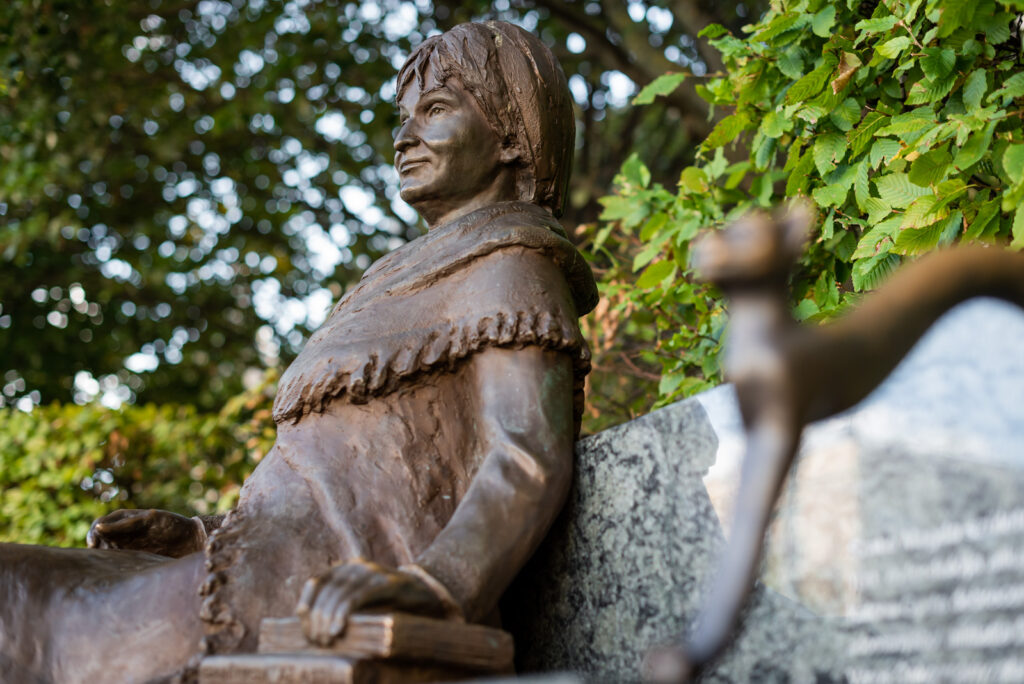
Stops:
Midwife Training Institute (Budai Ézsaiás u. 2)
The Midwife Training Institute was built in 1906 as institution of the Hungarian Royal Midwife Training Institute in today’s Wesselényi utca, between Vágóhíd utca overpass and Budai Ézsaiás utca. In the hospital wards of the midwife institute those suffering from illnesses of pregnancy and delivery were treated but also soldiers wounded in WWI were cured. Under such war circumstances was born Magda Szabó on 5 October 1917. Due to the increased risk of infection, her mother, Lenke Jablonczay’s life was endangered, she was sick for two years. Magda Szabó’s life was not envisioned a great future either. Her aunt, Piroska and her father Elek Szabó took care of the baby, while her mother lied in the hospital ward in puerperal fever and sepsis. As agreed, the baby received her father’s religion, she was baptised a reformed. According to the birth certificate, Lenke Mária Magdolna Éva Szabó’s parents were Elek Szabó town counsellor and Lenke Jablonczay, who lived in a house at Domb utca 16.
The Midwife Institute served the education of doctors and midwives as a university clinic as o 1921 until they both moved to the Clinics built at Nagyerdő (Woods) in 1927. Its building stills stands hosting the Bárczi Gusztáv Unified Medical Educational Methodological Institute.
The parents’ house (Szent Anna u. 22)
Magda Szabó was 3 years old when the family moved here. This through and through Catholic environment was not strange to her mother, Lenke Jablonczay although she was baptised reformed, she received a strong Catholic education by the decision by grandmother Mária Rickl and learnt in the neighbouring Catholic Svetits Institute. As Magda Szabó recalled, they lived in this home until 1933 that is when she was 16. From there, they moved to a flat on the upper floor of the house at Hunyadi utca 24. The house was in such a bad condition by the 1970s that it was no longer worth renovating. The last dwellers moved out in 1979. The house was finally demolished, and the Svetits Institute had its new wing built there.
Rickl-house (Piac u. 41)
The single-storey Classicist Rickl house is at Piac utca 41, the elderly know it as Lábasház (House with feet) as the building is an extension of a house with feet (a former warehouse) still standing. Magda Szabó’ maternal great-great-grandfather József Rickl German tradesman lived in the house as of 1786. According to the family legendary, he chose the plot when he was in Debrecen for the first time, he measured how many steps long the main street was and this house was in the very middle. Here he opened his convenience store called ‘The Turkish Emperor’ known in the whole town whose broad range of goods was spiced up by a prepared shark hanging from the ceiling. The Rickl family lived in the house for almost one and a half century up to its nationalisation. At the time, the house had 9 rooms, many offices and storage rooms, now it is home to smaller shops, offices. In the Lábasház still standing today in the courtyard, a pension and pizzeria have been opened.
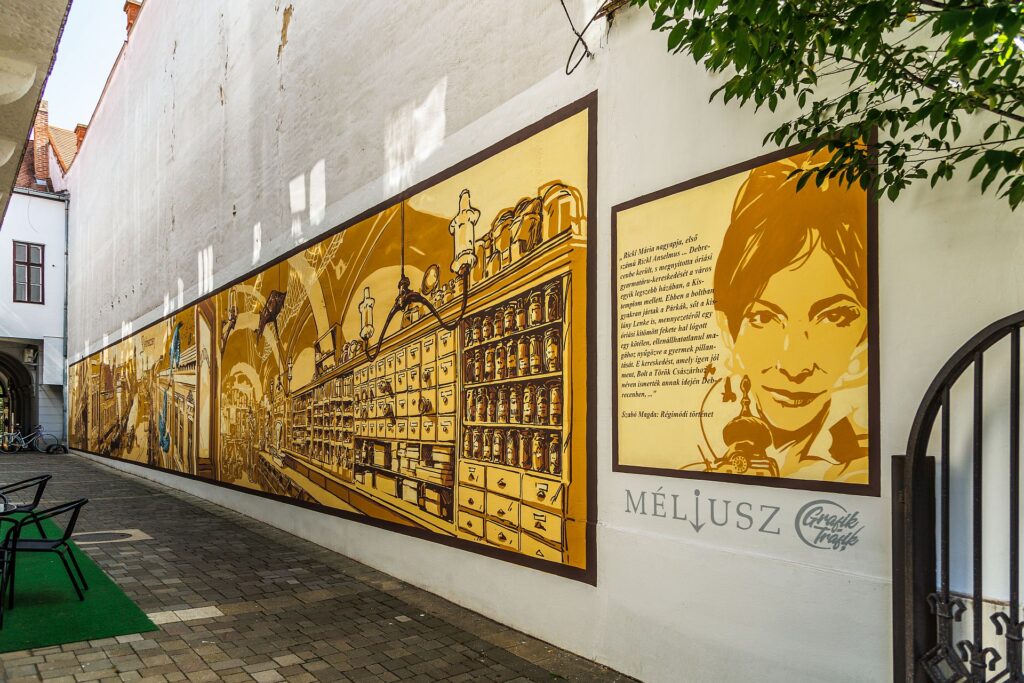
Town Hall (Piac u. 20)
As a small child, Magda Szabó attended the Town Hall regularly as her father worked here as a town counsellor. The writer returned here as an adult several times that was the most important place for her in the town besides the Reformed Great Church and Reformed College. Magda Szabó was elected Debrecen’s honorary citizen in 1977, she received the key to the town in 2007 on her 90th birthday.
The Town Hall is one of the most characteristic architectural memories of Debrecen. The building itself is not very old due to the fire ravaging many times in the last centuries in which the original Town Hall was badly damaged several times. The Town Hall as seen today built in Classicist style was built in 1843, but its history goes back to much earlier times. The core of the ‘ancient’ town hall was the stone house of András Tar chief justice of Debrecen purchased by the town in 1531. This was expanded by the surrounding citizen houses and plots in the coming centuries but the compound suffered serious harm in the fire of 1802. Afterwards, the two-storey Town Hall was constructed to be expanded to three storey in the last years of the 19th century when the building gained its current shape. The Town Hall, according to the Puritan taste of Classicism has one ornament: the coat of arms of the town in there the lamb carrying a flag, the Agnus Dei, a favourite symbol for Magda Szabó.
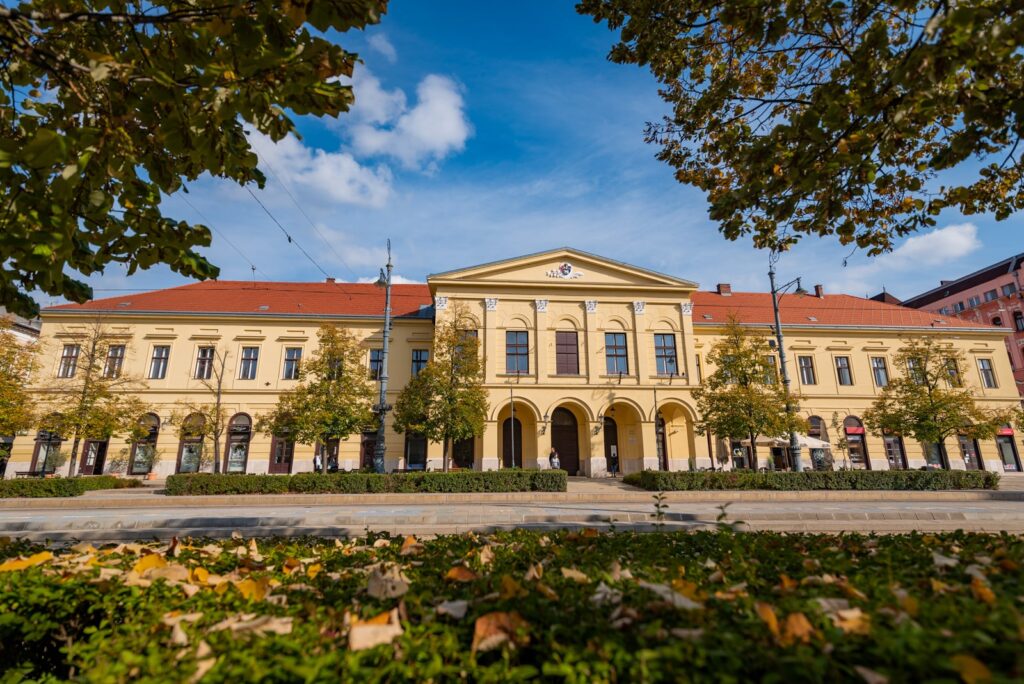
Dóczi Girl Education Institute and Szabó Magda Memorial house (Kossuth u. 35)
A school of Magda Szabó and her mother, Lenke Jablonczay, where the writer worked – between 1940 and 42 – as a teacher after completing her studies at the university.
The Dóczi Girl Education Institute opened in 1838. Its name stems from its director Gedeon Dóczy, who was the director of the institute between 1874 and 1908. The school reached its height between the two World Wars. At the time it had 1500 pupils. In 1948 the grade school of Dóczi was nationalised, its citizen school joined the elementary school that was founded at the time, its teacher training unit no longer started a first year in autumn of 1948 therefore it was dismantled by 1951. Its sole section that survived, the Girls’ Grammar School was organisationally added to the institutes of the Reformed College. The school returned to the reformed church after the regime change. It is one of the two secondary schools operating within the Debrecen Reformed College.
The Magda Szabó Memorial House opened in 2017 in the courtyard of the school on the occasion of the 100th anniversary of her birthday by the courtesy of Transtisza Reformed Church District and the City of Debrecen. The museum recalls Magda Szabó’s life, her tangible and intangible legacy via interiors from that time, personal relics and many photographs.

The first parents’ house (Domb u. 16)
In Debrecen’s old town the house stands at Domb utca 16 where Magda Szabó spent the first years of her life. The family lived here some years as of October 1917. The building hosts today a veterinary practice.
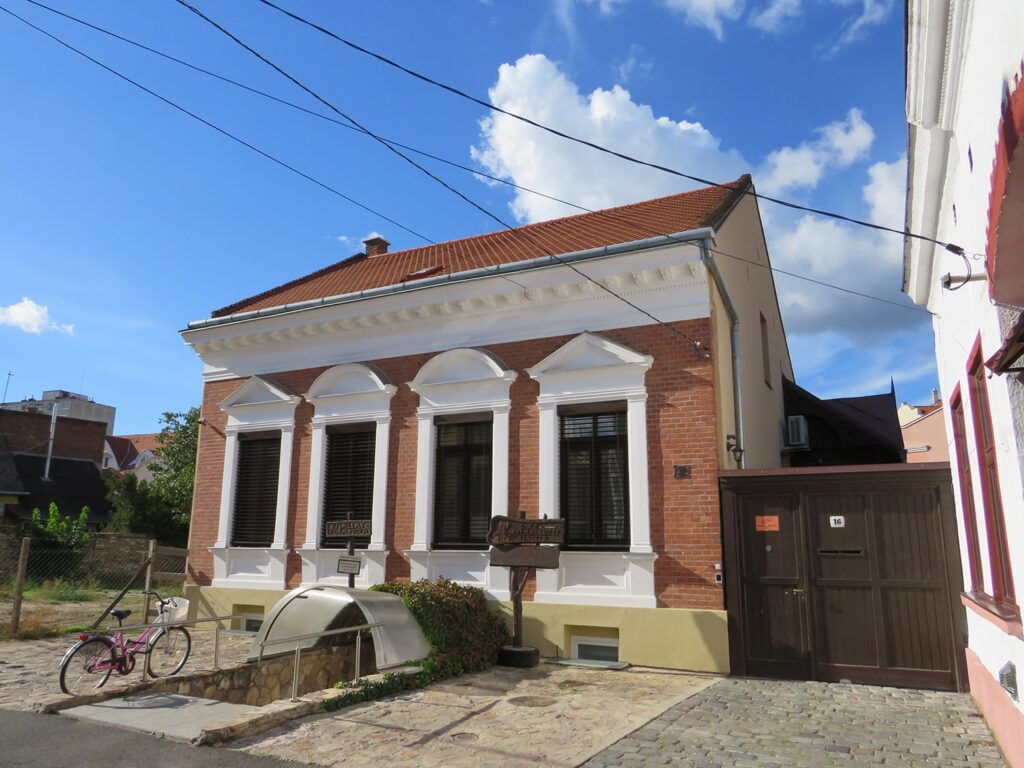
Debrecen Reformed College (Kálvin tér 16.)
The College was a relevant spot for the Szabó family, for several reasons. Magda Szabó paternal grandfather, János Szabó dean died while giving a speech in the Banquet Hall of the College. His sons were pupils of the College, among them Elek, father of Magda Szabó, with Endre Ady at the faculty of law at the university. Magda Szabó was presented to the audience of Debrecen in 1937 in the Oratory of the College at a public reading of the Csokonai Circle. The family survived the critical hours of the WWII at the bomb shelter of the College.
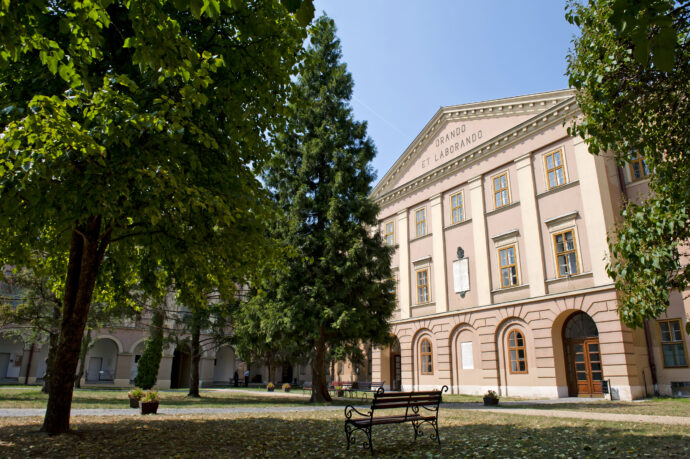
Memorial Garden and the Memorial Column of the Galley-Slaves
The Memorial Column of the Galley-Slaves is located in the Memorial Garden behind the Reformed Great Church. The memorial was erected on 21 September 1895 by courtesy of Widow Eufrozina Józsa Mihályné Hegyi, a woman from Debrecen. This was the first public monument in the town. This work commemorates the reformed benefactors and teachers who were sentenced to galley slavery in times of the Counter-revolution in 1673. Michiel De Ruyter Dutch admiral managed to free 20 of the dragged away benefactors from the Naples slavery on 11 February 1676. In addition to the Dutch ‘liberator’, the names of the benefactors dragged away can be read, among them one Jablonczay that reveals that the maternal ancestors of Magda Szabó included a Protestant pastor sentenced to galley slavery.
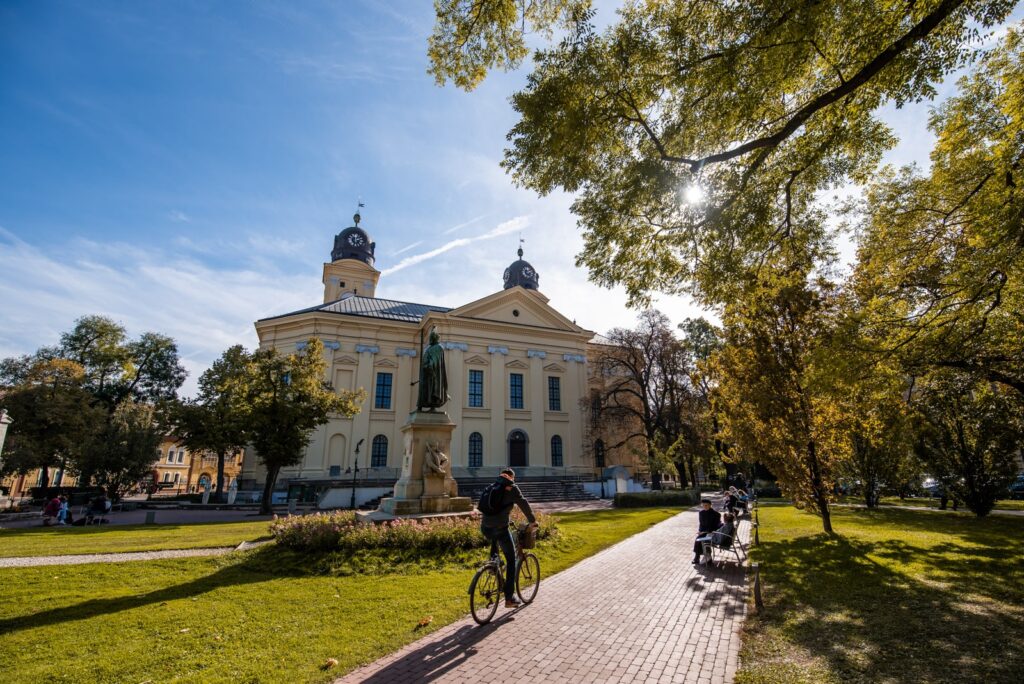
The Parents’ house at Füvészkert utca 18
Before the family moved into Füvészkert (arboretum) – at the time Baltazár Dezső – utca, they lived a while at Hunyadi utca 24 (today’s Petőfi square). Afterwards, they moved to the last residence of Magda Szabó in Debrecen, to Füvészkert utca 18 where earlier a student hospital of the Reformed College stood. Both the Hunyadi and Füvészkert utca homes were destroyed: the former was bombarded down in 1944 by the Americans, the latter was demolished along with the neighbouring Kölcsey house. At the place of the old Hunyadi street now stands the Petőfi tér, in 1978 the Kölcsey Cultural Centre was built at the place of the Füvészkert utca house, then Kölcsey Centre was built instead in 2006.
Jablonczay house (Bethlen u. 11)
The most relevant spot in the Old-fashioned story is the house at Kismester (called then Small Master) utca 11, Mária Rickl brought up here her grandchild, Lenke Jablonczay, mother of Magda Szabó. The house had been demolished, its place is occupied by the building of Kenézy Gyula Hospital and Polyclinic, Outpatient Care Centre, by common name SZTK.
Reformed Great Church (Kossuth tér)
The Reformed Great Church always played an important role in Magda Szabó’s life. The church – as an icon and key building of the reformed church – symbolises the religious roots of the writer and her family as well as her love of the city. The reformed church played a key role in Magda Szabó’s life, she took on even a position in the church: she was Chief Elder and Lay Vice President of the Synod of the Transtisza Reformed Church District between 1985 and 1990.
Where the Reformed Great Church stands now, there was a church already at the time of Árpád Dynasty but there are no data available about of its construction date. This previous church was rebuilt around 1290-1300 as it burnt down in the Mongol invasion. This medieval St. Andrew church was the largest church building of the Transtisza. It was fully destroyed in fire in 1564, there is only one remain, a huge carved arch stone with the symbolic flagged sheep, the Agnus Dei, which became the coat of arms of Debrecen. The reconstruction of the old church started in 1626 with Gábor Bethlen’s support. The town was exposed to fires in the coming centuries, thus, the church suffered so severe damage in the fire of 1802 that the old church had to be demolished. The Reformed Great Church as seen today was erected by the design of Mihály Péchy and József Tháler between 1805 and 1823.
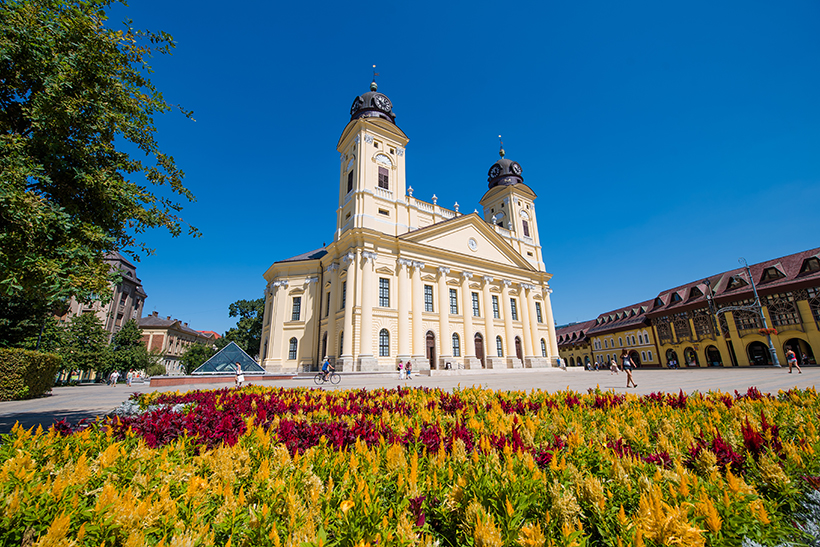
Magda Szabó statue (Kossuth tér)
The writer’s sculpture was unveiled on the occasion of the 100th anniversary of her birthday, on 5 October 2017 on the main square of the town. The work was donated by Gyula Katona entrepreneur of Debrecen to the town. The sculpture was made by Aranka E. Lakatos sculptor. The sculpture shows Magda Szabó in her sixties, the writer is sitting on a bench with two cats with books under her left hand.
Anyone can sit next to the sculpture to take a photograph.

University of Debrecen (Egyetem tér 1)
Magda Szabó studied between 1935 and 1940 majoring in Hungarian-Latin at the university from which she received a teacher’s and Doctor of Philosophy degree.
The Hungarian Royal University of Sciences founded in 1912 started to operate in 1914 at the Reformed College and in rooms rented in various areas of the town as there were not proper educational buildings initially. The patinated main building located in Nagyerdő and the neighbouring clinics block were built in the upcoming two decades as one of the largest investments of the country. The clinics main building and the university were officially unveiled on 28 October 1918, but the main building of the monumental university was no sooner unveiled than 15 May 1932. The first school year that could be started in the new university building was 1932/33. Magda Szabó could study already in this new building.
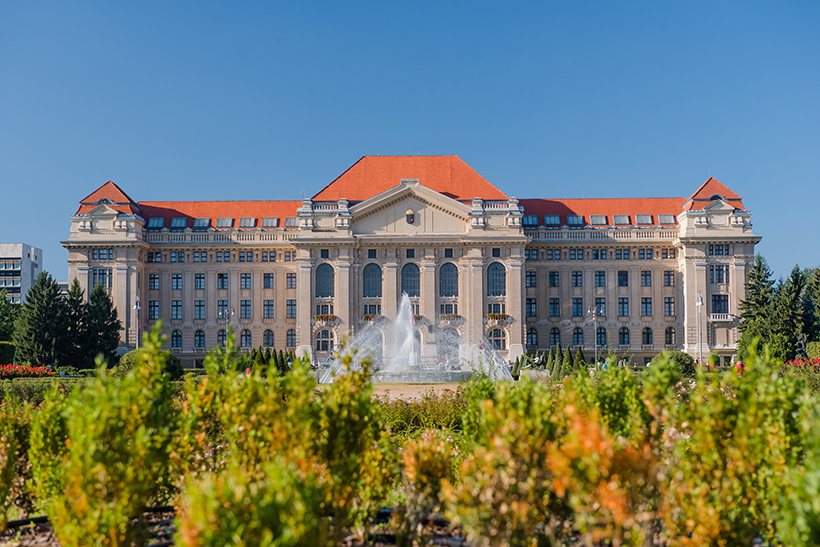
Debrecen Public Cemetery (Benczúr Gyula u. 6)
Magda Szabó’s parents, Elek Szabó and Lenke Jablonczay are buried here in this cemetery as well as Lenke Jablonczay’s mother, Emma Gacsáry and Lenke Jablonczay’s aunt, Gizella Jablonczay. A part of the writer’s ashes was also placed in the family tomb on 1 December 2007. In accordance with Magda Szabó’s last will, a part of her ashes is in the Public Cemetery of Debrecen, in her parents’ tomb, another part is in final resting place in the tomb of her husband, Tibor Szobotka, in Farkasréti Cemetery of Budapest.
The texts were drawn up based on László Balogh’s study entitled Magda Szabó’ residences in Debrecen and Magda Szabó’s Debrecen – Literature Guide (2018) edited by Mariann Keczán.